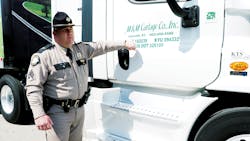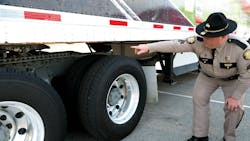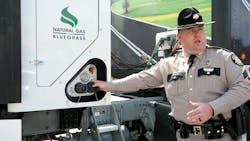While most trucking fleets place due emphasis on the driver’s safety responsibilities behind the wheel, all too often management has been less diligent when it comes to the day-to-day chore—and it is a chore—of equipment inspection. Thus, trucking gets oversight from the Federal Motor Carrier Safety Administration (FMCSA), with thousands of pages of U.S. code devoted to equipment and inspection standards, and the Compliance Safety Accountability (CSA)program that formally ties drivers and their companies together in the compliance effort.
But just because maintaining a safe vehicle can be complicated, a solid equipment inspection program doesn’t have to be. Indeed, such a program should be designed to be simple. And experts in training, enforcement, and truck maintenance agree that the basic formula for success is to have a plan—and stick to it.
“We evangelize that you have a process,” says Joel Landsverk, product development manager for training for J.J. Keller & Associates. “Every vehicle, every rig, every person is different, so if it works for you to start at the engine bay and work your way around, fine. If you’d rather start at the back, do it that way. Just have a process and do it the same way all the time.”
And prescribing a system, making it “rote,” is the key to consistency.
“If you get into a habit of doing inspections wrong, you don’t know that. Drivers are out on the road for a long time. They’ve done a hundred inspections or more since the last time you saw them. That can be hard to undo,” Landsverk continues. “You want to set the right expectations and provide them with a really good recipe for how to do it right. It’s a good practice for a company to find an inspection system that works for them and stick to it. Make sure everybody knows what everybody’s talking about every time you talk about inspections.”
Andy Blair, who currently serves as fleet safety director responsible for more than 900 vehicles, agrees. Often, he suggests, drivers haven’t received instruction on how to do a proper pretrip since they passed their commercial driver’s license (CDL) exam, and they’re left to “kind of do their own thing.”
“Companies should have a standard way to do a pretrip,” Blair says. “Always do it the same way, so you don’t miss things.”
Blair founded his consulting company, DOT Safety Checkups, after a long career in local law enforcement that included Dept. of Transportation (DOT) inspection authority. He quips that when he sees enforcement officers he used to work with, he tells them, “I’m making it so our trucks are boring for you to stop and look at them.” He adds that he does “many, many more” Level 1 inspections on the large fleet than he ever did as an officer.
“We’re boring, but it took a while to get there. It’s a continual cycle of drivers doing their part and the company doing theirs. It’s got to be two-way street. Fleets need to understand that they need to get the drivers to participate. And they need to show the drivers that they’re willing to take care of what the drivers write up,” Blair says. “When drivers see that, they are much more likely to do a good job with the pretrip, and they want to stay with a company that has their back. But they’re not going to keep writing it up if the company doesn’t want to fix it. Those are the companies where drivers come and go.”
And drivers, for their part, need to fully appreciate the importance of maintaining their equipment and not taking shortcuts, emphasizes Sgt. Jason Morris with the Kentucky State Police Commercial Vehicle Enforcement (KSP CVE) division.
“I know common sense can’t be built and bought, but think about it: Put your family in the seat next you. Why would a commercial driver, knowing that he’s got four bald tires and it’s raining, put himself and his family—and the motorists around him—in that situation?” Morris says. “Common sense would help a lot more than anything else I can say. Be diligent.”
The basics
Morris recently took Fleet Owner on a basic roadside walk-around, pointing out the rulebook specifics and providing additional commentary on the real-world impact of various violations. The regulations are widely available, of course, from FMCSA, the Commercial Vehicle Safety Alliance, CDL schools, state associations, and safety training service providers. The real takeaway from the demonstration inspection is how much Morris and other roadside enforcement officers are guided by feel, by intuition, by experience.
For starters, he can literally spot you coming from a mile away.
“We have purchased Fujifilm binoculars that have stabilizing devices,” he says. “I can see you down the road and read the name on your shirt. I sit on the crest of the hill, and once you come across, I’m looking at everything you’ve got.”
Morris isn’t a fan sitting on the side of the road and punching in DOT numbers to determine which trucks to pull over. “By the time it takes me to enter that, that driver has gone and there’s two or three other trucks that have come by. I’ll just sit and watch the cab: I watch the driver’s habits. For most, when you see a police officer, you look at him. If a driver comes by and he’s 10-and-2, really trying to lay back and hide his face, I’m thinking: What’s he got?”
He also notes a couple of items that always catch his attention:
◗ “I’ll stop you every day for a dirty windshield, because if you didn’t take five minutes to clean your windshield, I know you haven’t done your log or a quality pretrip.”
◗ “I’m big proponent of seat belts. I’ve worked a great many accidents where I could say, if that fella had had his seat belt on, he could’ve walked away. I’m still citing truckers—every day.”
The Kentucky Automated Truck system (KAT) at weigh stations, however, uses a set of cameras to instantly glean vehicle identification and then query “multiple databases” for company information and inspection history. As to which trucks get pulled over, “a lot of it still depends on if the officer knows the company,” Morris explains. “If I see a company I’ve never seen before, I may just stop you to find out who you are. If it’s a company that I know is in good shape all the time, I’m not going to stop that truck unless I see a violation.”
At the roadside, KSP CVE officers approach a truck from the passenger side. The officer will knock and ask the driver if he might open the door.
“I always begin with, ‘You’re not in trouble,’ ” Morris says. “The common misconception is when we stop somebody, they’ve done something wrong—and that’s not true.” It is true, however, that Kentucky has a minimum number of inspections required to retain federal commercial vehicle enforcement funding. “So there’s times we’ll just sit out on the interstate and every 25th truck gets stopped.”
A Level 2 vehicle inspection often is the result of the enforcement officer simply noticing something amiss as he approaches the cab for what otherwise would have been just a basic driver document check. And a Level 1 remains an option if the officer detects something like an air leak.
“We’re always looking, listening, and smelling as we’re walking down the truck,” he says. “But if the driver will do a good proper pretrip inspection, 95% of the time he will avoid anything with us. If I look in the log and I see you’ve done a pretrip, I take it as face value that there should be no defects on this vehicle unless you’ve noted that in your daily vehicle inspection report. If you have that marked, unless it’s something that’s detrimental, we may not do anything on that. Inspections aren’t necessarily to find a violation; it’s for safety—for the driver and the motoring public.”
Morris actually has high praise for many of the truck drivers he encounters.
“The majority of your drivers out here are very capable. They’re there for a reason; they’re professionals. We know that,” Morris says. But how does he recognize that professionalism at the roadside? “A lot of it is appearance. My father was a truck driver. He had a button-up shirt, his jeans were pressed, and he had a shower every day.
“You can tell when an individual takes pride in his appearance and his equipment. If I open up that passenger door and two weeks’ worth of trash comes falling out, but you were just at a fueling stop yesterday, so wasn’t there a trash can?” he continues. “It comes down to pride.”
Finer points
Blair, the former officer and now safety consultant, also offers many of the same points regarding the importance of professionalism and proper inspections.
“There aren’t many trucks that have absolutely nothing wrong with them. It was extremely rare I’d write a citation—unless the driver talked me into giving them a citation I was not planning to write,” Blair says. “You may not enjoy being stopped, being inspected, and dealing with an officer, but at the end of the day, whatever feelings you have you might just want to hold onto until you drive away—then go ahead and let ’er loose.
“It just doesn’t benefit you to give the officer a hard time. At the end of the day,” he continues, “your being cooperative and pleasant can go a long way in how many autographs you get.”
And he, too, worked his way up the inspection intensity from the obvious after encouraging drivers, “Tell me now.”
“I was more than happy to cite a driver for things they absolutely should have caught on the pretrip. Things that were not so obvious underneath the truck, I would cite the company not the driver,” Blair says. “Tires don’t go bald between 7 a.m. and 11 a.m. Fire extinguishers don’t discharge. Triangles don’t go missing.”
A trucking company doesn’t have to have sophisticated inspection tracking software to get a sense of troublesome trends, he points out: A quick look at FMCSA’s Safety and Fitness Electronic Records (SAFER) System log of violations should indicate problem areas. Of course, a company’s inspection data is also a major component in the roadside enforcement system that prioritizes trucks for inspection, red-lighting those from a fleet with ongoing issues.
“It takes a while to get in the red area—and it takes a while to get out,” says Blair.
And when things do go wrong at the roadside? Blair offers tips on how not to make an out-of-service (OOS) worse:
◗ You cannot cause or create a violation to fix another. So you can’t remove a front turn signal bulb (not OOS) to fix a rear turn signal bulb (OOS).
◗ You do not have to be a certified mechanic to fix anything except for making brake adjustments. “I don’t want someone adjusting brakes who saw another driver do it at the truck stop several years ago,” Blair says. But you can be trained by a mechanic to do it, he adds.
◗ You do not have to show or prove that you fixed something unless the officer is going to wait and watch. They will usually trust the driver “to do the right thing”—or face a very stiff fine if caught down the road. If the officer leaves and you have fixed the violation ... just go. But if the violation is not OOS, it doesn’t have to be fixed immediately.
◗ Understand the details and percentages of combination brake OOS—because not every roadside inspector does. (Blair notes that he’s won 13 of 18 DataQ challenges related to combination brake violations, and feels he “should’ve won ’em all.”) Similarly, pictures from the inspection are “a great, great help,” both for potential challenges and for a record of repairs.
◗ Daytime or lack of rain is not a repair—or grounds to leave—for non-working lights or wipers. OOS means OOS until the violations are fixed.
◗ OOS means you are shut down where you are placed OOS. You can ask the officer if he/she can actually follow you down the road a couple of miles to a parking lot, for instance, to put you OOS. Both the truck driver and the officer need to think ahead: How safe is it to try to perform a fix along the road? You aren’t OOS until the officer marks and declares you to be OOS.
Training
Safety and compliance specialist J.J. Keller & Associates has been offering driver training materials for tractor-trailer inspections for 20 years, explains Landsverk. The current line of products, which covers pretrip, en route, and post-trip inspections, comes in video-book, DVD or online delivery formats.
An advantage of using an outside resource for inspection training is consistency over time, Landsverk suggests.
“Each trainer or company might have their own way of doing things, but sometimes that tribal knowledge can get lost along the way,” he says. “If you lose that veteran guy or gal and if you have a product like this, you can make sure that everybody who comes in the door is getting that same training, that same message—that all of this is important.”
Whether the fleet is large or small, understanding “the intricacies” of vehicle inspection is critical.
“Every day, the safety of that driver and the safety of the other drivers on the road relies upon a driver’s ability to perform a high-quality inspection,” Landsverk says. “They’re complex machines, they’re big, and they take a ton of abuse. Without that driver’s early attention, it’s a disaster waiting to happen.
“But because this topic is detail oriented and process oriented, it can be difficult to sit through a classroom and really get your head around it. With online training, you can really take your time and review topics on your own time without the embarrassment of asking a question in front of the other drivers.”
Additional resources, at least as far as the basics go, include traditional CDL training manuals that include pretrip diagrams and “memory aids.” A YouTube search turns up a number of video walk-arounds of varying detail and quality.
Landsverk is a fan of app-based, mobile checklists (some with reporting and remote monitoring features) to ensure no inspection items get left out.
“A pretrip inspection can take 20 minutes, and even though the driver is very familiar with the vehicle and they’ve been through the process a lot, they can still get into a zone and forget stuff—especially if you’d had a bad morning and you’re already late,” he says. “It’s just not a part of the job that’s terribly well promoted: Oh, by the way, you have to do this every day.”
And oh, by the way, it’s critically important.








